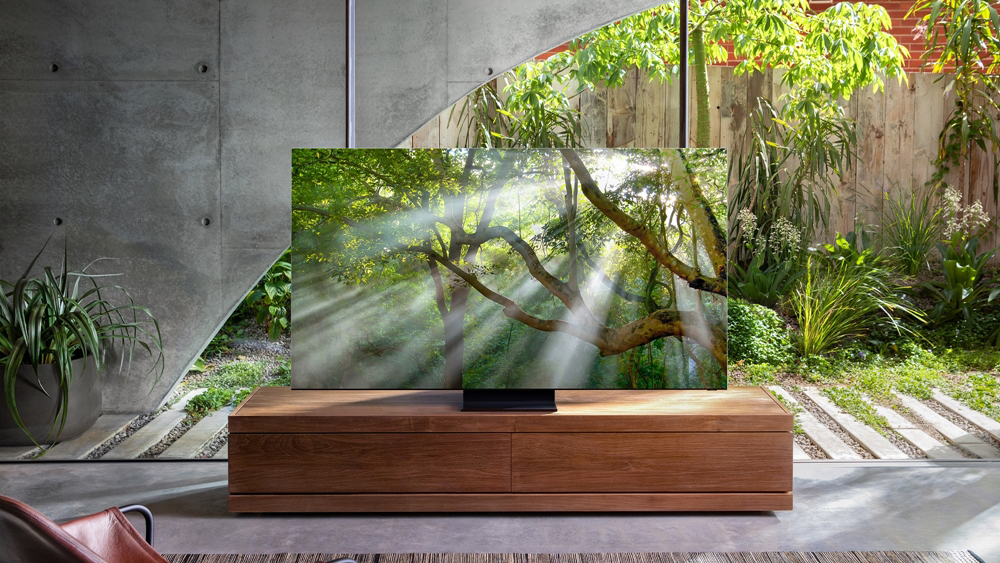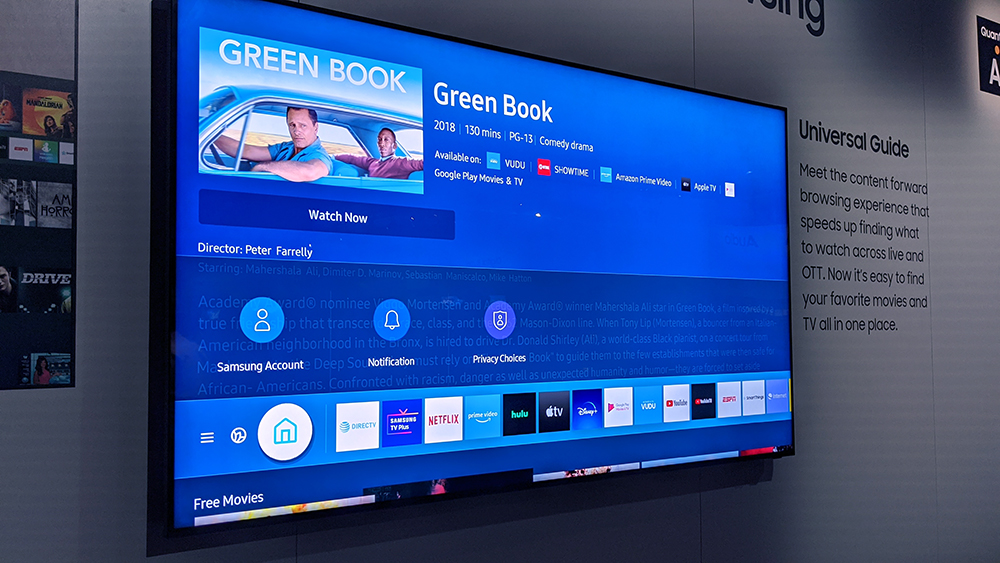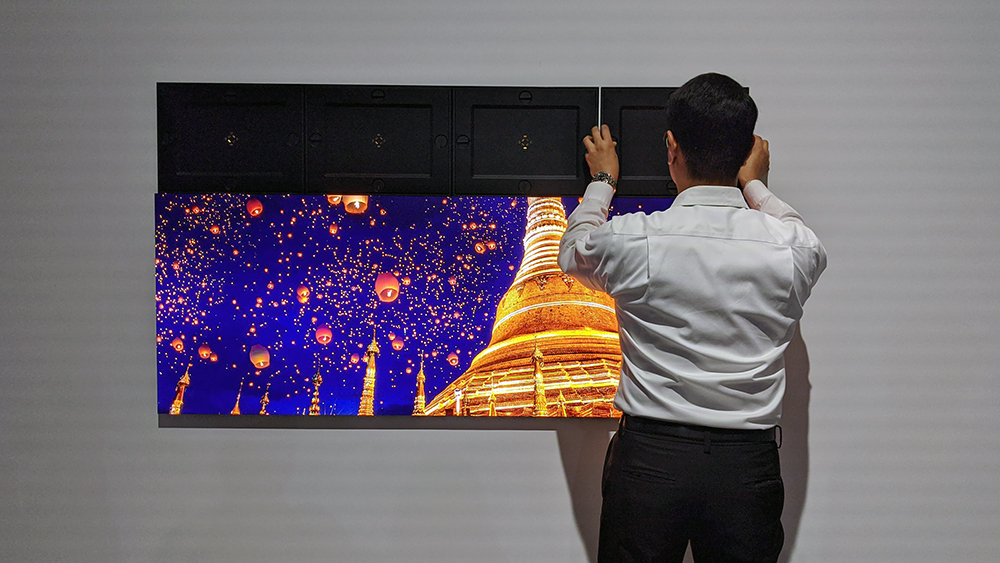How Samsung’s 2020 QLED TV strategy plans to topple OLED
It's all about improved brightness, shading and detail for Samsung's new 8K and 4K QLEDs...

While Samsung is allegedly set to run with a hybrid QLED-OLED (QD-OLED) technology in the not-too-distant future, and has a longer-term plan for the almighty rise of MicroLED TVs, for now the Korean giant is predominantly sticking with its QLED guns.
We don’t blame it. Samsung has invested heavily in the Quantum Dot TV tech and, thanks to regular updates, it now truly rivals at OLED at the top of the TV tech pile. The QE65Q70R was our favourite midrange 65-inch TV last year, and of the flagship QE65Q90R we said it was, “a QLED that does things only an OLED previously could”.
This year sees the expansion of Samsung’s 8K and 4K QLED TV line-up for 2020, which naturally promises a next-generation picture performance over last year’s models, as well as new sound features and an improved user experience. MicroLED TVs – widely heralded as 'The Future Of TV' – may still be too pricey a proposition for most living rooms, but 2020 also sees Samsung’s MicroLED efforts taking another step closer to being a viable consumer option.
We visited Samsung’s HQ in South Korea at the tail end of last year, and learned more than a thing or two about the brand’s 2020 TV line-up, which has just been unveiled at CES 2020…
The numbers, the names
“8K demand surpassed expectations in 2019”, according to Samsung.
Samsung has so far been the TV manufacturer shouting loudest about 8K TV, and it hasn’t been all talk and no trousers – a handful of Samsung 8K models were on sale last year, and while we concluded that the brand’s flagship 4K TV represented better value for money for now, we were still impressed.
Unsurprisingly, Samsung has expanded its 8K TV line-up for 2020. More excitingly, prices of at least one will, according to Samsung, be in-line with those of the flagship 4K TVs. The 65-inch version of the top-tier Q950R 8K TV launched at £4000 last year, but it seems we could well see a 2020 8K TV version for nearer £3000/£3500. We await confirmation of this year's prices.
The latest hi-fi, home cinema and tech news, reviews, buying advice and deals, direct to your inbox.
So, Samsung’s 2020 TV line-up peaks with two 8K QLED TV ranges: the Q800T and flagship Q950TS (Q950S in the US). The latter is notable not only for its picture tech, which we’ll come to, but also for the fact it, a) sports Samsung’s new, zero-bezel ‘Infinity Screen', utilising 99 per cent of the screen, b) is only 14.9mm-thick (despite being a FALD set), and c) has eight speakers around its frame: a tweeter and midrange on each side, two tweeters at the top, and a subwoofer at the bottom.
Below those 8K TVs sit the more predictably structured 4K QLED TV ranges: the Q60T (which replaces last year’s RU800 LCD series), Q70T, Q80T, and Q90T (the UK could also get a very similar, OneConnect box-toting model called the Q95T).

Picture: improved brightness and detail
For its 2019 QLED TVs, Samsung’s focus was on enhancing black levels and viewing angles – which we can heartily say duly paid off. For its 2020 TVs, Samsung has concentrated its efforts on improving brightness, contrast and details. Thanks to next-gen Quantum processors – one for its new 4K TVs, another for its new 8K TVs – more advanced AI upscaling trickery, plus improvements to Full Array Local Dimming and motion performance, Samsung’s 2020 line-up looks on track to further the company’s recent success. Naturally, Samsung believes it has the recipe to outclass rival OLED TVs.
While Samsung’s 2019 4K and 8K QLED TVs use machine learning to create a formula for upscaling content with a lower resolution than the panel – a technique adopted by other TV manufacturers – the 2020 TVs advance the upscaling process by adding a ‘deeper’ algorithm on top. Samsung calls this Deep Learning Super Resolution.
It’s a database of images with numerous layers of algorithms, each of which provides a different interpretation of the data that the TV can use to help create the most realistic upscaled picture. Essentially, Deep Learning SR is a more intricate way of processing data, and has been created to make upscaled content look better than ever. That's the theory, at least.
The 2020 TVs with full array panels (the Q80T, Q90T, Q800T and Q950TS) should benefit from efficiency improvements that Samsung has made to its Full Array Local Dimming (FALD) system too. By redistributing power from the darker areas of the panel to the brightest areas that need it most during a scene, Samsung claims that highlights can be up to 20 per cent brighter.
We were shown stock content on both the 2019 and 2020 flagship displays, which were side by side and set to Samsung’s choice of settings, and the 2020 TVs surfaced more subtle details and shading – if anything, some details looked too keenly etched – and the brightest parts of the picture were notably, and beneficially, brighter. We await hands-on time with the 2020 TVs to see how these technologies truly play out in the finished article, but first impressions are positive.
As for the edge-lit QLEDs TV (the Q60T and Q70T), they now have a row of both warm and cool LEDs at the bottom of their screens so both can be used, or some more than others, to change the colour temperature of the backlight to best deliver the specific scene on-screen.
We were impressed with the concept and the execution of what Samsung is calling Adaptive Picture+, a mode that automatically optimises the brightness of the TV based on the lighting in your room. On more than one occasion we've seen HDR-graded content that looks excellent in optimal dark conditions but not so much in well-lit rooms. Adaptive Picture+ aims to remedy that.
Samsung is introducing active tone mapping on a per-frame basis for HDR material, too, essentially bringing dynamic mapping to HDR10 so that it works like the intrinsically dynamic HDR10+.
Last but not least, we’ve good news for gamers, too: Real Game Enhancer+ claims to improve motion performance by 40 per cent, while a new multi-view allows owners to play a game while, say, watching a YouTube tutorial at the same time.
TVs and soundbars in symphony
Samsung is ramping up its efforts to enhance sound, too, and to help it achieve that is a new feature called Q-Symphony. It’s a collaboration between Samsung’s 2020 QLED TVs and Q-series soundbars that aims to produce a more immersive audio experience. Rather than the TV speakers being mute when the soundbar is connected, they will be used alongside the drivers in the soundbar. Intriguing.
As for the audio coming from the TV itself, the enhancement here lies with Object Tracking Sound. OTS+ is the term for the 8K TVs’ 4.2.2-channel configuration, while it’s just OTS for the Q80T and Q90T 4K TVs’ 2.2.2 speaker set-up. The aim is to better represent the direction of the sound, so if a helicopter flies from the bottom of the screen to the top, the audio will do just that. The TV achieves this by positioning the soundtrack on a horizontal plane, analysing it, and then sending sounds to specific TV speakers.
The sonic sibling to Adaptive Picture+ is Adaptive Sound+ (or AVA, Active Voice Amplifier), which improves the clarity of voices when the TV detects an increase in surrounding noise. It worked well in our slightly bizarre demo which saw a vacuum cleaner turned on near the TV - and the TV's volume adjusted accordingly.
A new universal guide

The user experience of Samsung's Tizen smart platform is already one of the most intuitive around, but new tweaks aim to make it even more so. A new universal guide will combine OTT services such as Amazon Prime Video, Netflix and Freeview channels to display a one-stop-shop interface, organised into sections such as ‘On Now’ and ‘Continue Watching’.
Which services’ content will be included depends on what service metadata Samsung can pull, but we’re told by a Samsung representative that the bigger services such as Amazon and Netflix will be on-board at launch.
Users will also be able to see more services at once on the home page’s pull-up scrollbar as Samsung has changed the icons from rectangular to square. And in addition to built-in Bixby control, 2020 QLEDs will have Amazon Alexa and Google Assistant integrated, activated by a button on the remote control. Could this be the beginning of the end for Bixby?
When it comes to connecting to other devices, the new 'Tap View' feature allows users to mirror their smartphone to their TV, while the 'Digital Butler' function will allow the TV to recognise and control not only devices connected via Wi-Fi or Bluetooth but also, somehow, legacy, non-smart devices such as an old dehumidifier.
The existing Ambient Mode, which allows users to display artwork on the TV when they aren’t watching it, has been developed too. There’s now more artwork to choose from and as an alternative users will also be able to upload their own photos and videos from their Samsung smartphone (iPhone support could also soon be on the cards).
MicroLED: the bigger strategic picture

MicroLED hasn’t strayed far from Samsung’s focus in recent years, the technology is very much part of the company’s future TV propositions, and in 2020 Samsung is progressing into more sizes and packages. This year it comes in 75in, 88in, 93in and 110in 4K resolution screens, and 150in and 292in 8K screens, with those under 100in framed and pre-assembled (like a normal TV) and those above 100in expandable and requiring installation (like Samsung’s The Wall).
These MicroLED displays will inevitably cost an arm and a leg (or maybe even two of each), and for that reason Samsung is expected to push them to the B2C market as opposed to the consumer one for now... even though they apparently do already exist in a few living rooms. But Samsung is still showing the entire MicroLED line-up at CES 2020, demonstrating the flexibility and (if you ask us, hugely impressive) picture potential of the technology, which is capable of being almost free of size, ratio and resolution limitations, and boasts a durable lifespan of up to 100,000 hours.
What is MicroLED anyway? In short, MicroLED is a self-emissive technology (meaning each pixel can turn completely off for unrivalled black depth), like OLED. The main difference is that they use tiny, non-organic RGB LEDs – three per pixel. These LEDs will supposedly be capable of four times the brightness of OLEDs, and because there’s no need for a colour filter for them to shine through, they are more power-efficient too.
Samsung seems to be advancing the performance and efficiency of the product year on year. For example, this year’s MicroLEDs have an optimised backplane thanks to a material move from PCB to TFT glass. It may be a few years off affordability yet, but having seen how gorgeous it looks we reckon it’ll be worth the wait.
So it's better-than-ever QLED technology for now, 8K resolution screens with improved upscaling next, and MicroLED later... Samsung's TV strategy sounds good to us. We look forward to seeing how the other big players in the TV market set out their stalls for 2020 and beyond in the coming days and weeks.

Becky is a hi-fi, AV and technology journalist, formerly the Managing Editor at What Hi-Fi? and Editor of Australian Hi-Fi and Audio Esoterica magazines. With over twelve years of journalism experience in the hi-fi industry, she has reviewed all manner of audio gear, from budget amplifiers to high-end speakers, and particularly specialises in headphones and head-fi devices.
In her spare time, Becky can often be found running, watching Liverpool FC and horror movies, and hunting for gluten-free cake.
